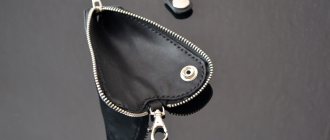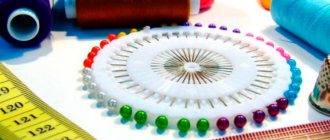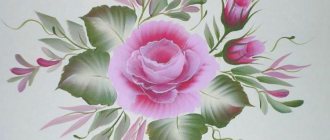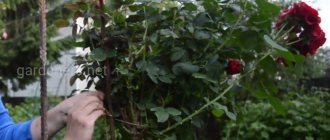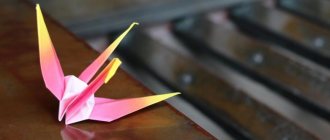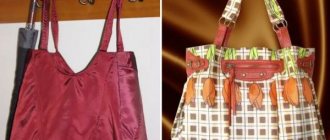Flowers made from fabric are not just a beautiful and spectacular craft, but also an excellent decoration for clothes, bags, belts, hairpins, headbands and other accessories. They will be an excellent basis for making necklaces, brooches and other original jewelry that will be appreciated by both girls and young fashionistas.
To create truly beautiful roses, it is not necessary to use special tools and expensive impregnated fabrics. It is quite enough to have ordinary rags, scissors, and needles.
Roses made from raw fabric pieces
Material
It can be with a pattern, or just plain. It is easiest to work with non-slip fabrics that have a medium density. If you use calico or chintz, it is not necessary to use scissors. These fabrics tear well. The edges are left raw. The protruding threads form a light fringe, which will give the roses even more charm and charm.
Size
The longer and wider the strip, the larger the finished rose. To get a composition of flowers of different sizes, use strips of different sizes. From a strip of 40 by 1.5 cm you will get a rose with a diameter of approximately 3.5 cm.
Forming a rose
The finished strip is twisted around a knot tied in the middle - the core of the rose. The knot is made as tight as possible. The ends of the strip are folded together and wound in a spiral around the middle. Work must be carried out on a flat surface. The strips are slightly twisted among themselves and separately. The formed “snail” is secured with pins so that it does not fall apart.
A delicate rose with thin petals is created using a more complicated design. One of the ends is folded lengthwise and twisted two or three turns. The fabric is wrapped around the formed center, as in the previous version, but in one layer.
Fixing the flower
The resulting rose must be secured to a non-falling material. The ideal option would be a circle cut out of felt. The flower is glued or sewn.
Kanzashi technique
The creation of multifaceted flowers from satin ribbon began in Japan. Then the technique of making decorative bouquets and panels was adapted by European craftswomen.
Detailed instructions on how to make flowers are posted on social networks. Everyone brings something new. The tape is folded like paper in origami.
The cut edges are melted over the flame of a candle or lighter. They do not crumble after this treatment. Ribbons make magnificent dahlias, roses, and daisies.
Floral decor made using the kanzashi technique always looks unusual. Use tape of different widths and shades.
The petals are made single and double, concave and convex, sharp and rounded. The result is high-quality decor for interiors and accessories.
Simple rose made of synthetic fabric
Material
The ideal option would be shiny or transparent fabric. Organza, satin, tulle and similar materials are perfect.
Creating petals
You can cut the petals one at a time or several at once. In the latter case, the process will go much faster and easier. To cut out several petals, the fabric is folded in layers, secured in the center and cut out. Melt the edges of the elements over a candle flame. This must be done as carefully as possible.
Forming a rose
The petals begin to be sewn from the middle. The smallest ones are used first, gradually moving on to the larger ones. The resulting center of the rose, which is not too lush, can be decorated with beads, rhinestones, and stones. This will create the effect of a fully bloomed flower.
Unusual Effects
Roses made from fabrics of various shades will look very original and truly chic. They can form a smooth transition from dark to light or be located in an impromptu “mess”. There are no restrictions. The main thing is to think through the concept in advance, because the petals will have different sizes.
Unusual “swells” when singeing petals over a candle are obtained when non-100% synthetic fabric is used. This effect looks very original, giving the rose a special zest.
Flowers of different types
Textile decor is becoming one of the original and stylish ways of decoration. Flowers can be flat, voluminous, collected in a bouquet, wreath, composition or panel.
Products can be created from felt, burlap, denim. They are suitable for decorating large objects. And cute creations made from nylon, organza, fine knitwear, chiffon look elegant, delicate and close in appearance to the original.
The choice of fabric for the product depends on the purpose of the decorative element - a flower on a stem, an element of wall decoration, clothing or a wedding wreath.
Note!
DIY satin ribbon bows: photos of original design ideas, step-by-step DIY master classDIY hair bands - ideas for decorating homemade rubber bands + step-by-step instructions for making them yourself
DIY shadow theater: step by step how to do it at home! 175 real photos
Having mastered the technique of work, you can reproduce flowers from the fabric of leading masters, guided by master classes, or create an original product, emphasizing your individual style.
Rose made of figured fabric strip
Textile
Flowers with curly edges are made from any thick material. This is due to the fact that the strip is not twisted or deformed, but is cut out with a figured edge.
Cutting out a strip
If the edges of the fabric do not fray, it does not need to be processed, you can immediately begin cutting out a strip with a wavy edge. The size and shape of the wave are chosen arbitrarily. The main thing is that it has a smooth transition along the top edge. The fraying fabric can be first processed or cut in half, stitched, and then turned inside out and straightened out the seam.
Forming a bud
The strip at the bottom is stitched with small stitches, the thread is pulled together so that a bud is formed. Basically, the buds are not simply made as a separate element, but are fixed onto a stick simulating a stem. The attachment point is covered with sepals made of green or another shade of fabric.
Process of creation
To make a flower you will need:
- textile;
- scissors;
- glue gun;
- decor replacing stamens;
Step-by-step making of flowers with your own hands:
- the fabric is cut out according to a template: each petal is cut out individually or the edges of round blanks are cut in four or six places (for roses, buttercups, large petals are needed, for rose hips, peonies - small ones);
- the blanks are laid out on the table;
- light a candle;
- each edge is melted by passing it over a flame; a light touch is enough, otherwise the fabric will burst into flames;
- the petals are laid out according to format, the bud is tried on;
- The flower is assembled using a glue gun: one piece is attached to another with a drop of glue;
- the center is being established.
A pin is glued to the bottom of the brooches and secured with a strip of fabric.
Rose with smooth edges
A rather labor-intensive and complex option for creating roses, but at the same time it allows you to get truly beautiful, festive-looking flowers. Made from satin, they are suitable for creating a whole bouquet, which will be a wonderful gift for a birthday or wedding.
Pattern
Fish-like petals are cut out of satin fabric. They must be absolutely symmetrical both across and along. The easiest way is to make a small rose first. It is best to use as non-slip a fabric as possible. It is enough to make 7-8 “fishes”, the length of which varies from 6 to 7 cm.
Creating petals
Each piece is folded in half so that the right side of the fabric remains on the outside. Two petals overlap each other. The raw edges of both the left and right elements should be completely aligned.
In a similar way, all the petals of the future rose are placed in a chain and pinned.
Forming a rose
The collected petals are stitched with small stitches, departing from the rounded edge by about 3-4 mm, and then pulled together. In one neat movement, roll the rose from one end to the other. To prevent the flower from falling apart, it is fixed at the bottom with threads. The finishing touch is to sew on green decorative leaves.
Decorating clothes with fabric roses does not imply that the flower is sewn onto it. For this purpose, use Velcro or pins. This allows you not only to wash your wardrobe items without any problems, but also to change one rose for another, depending on your mood or occasion. A chic rose made from satin or other fabric, made by yourself, can turn everyday clothes into an excellent holiday outfit.
Realistic and wonderful
The most skillful and patient craftswomen will be able to create the next flower.
Prepare cloth (ordinary cotton), gelatin, balls, soldering iron, scissors, fabric paint, brush, glue or hot-melt gun.
To begin creating this beautiful fabric rose, you need to soak the material in gelatin. To do this, prepare a solution: put 2 teaspoons of gelatin in a container, pour 100 ml of cool water into it, and leave for an hour to swell. Add another 150 ml of water and heat until the gelatin dissolves. Bringing this solution to a boil is strictly prohibited!
Dip the fabric into hot gelatin, gently squeeze out excess moisture (without twisting) and dry, straightening out the folds. After proper processing, the fabric will rustle.
To make a beautiful rose from fabric, patterns are a must! Take a real living rose and take it apart into petals. Trace them along the contour on thick cardboard and cut them out - these are patterns.
Now we cut out the petals from the fabric. All details are cut on the bias, otherwise you will not be able to give them a natural shape.
The next stage is coloring the petals. Take food coloring - they are the most affordable and quite easy to work with. Paint to your taste, there is only one rule: closer to the center of the flower, the color intensity increases.
For the large outer petals, add a little green at the base. We carefully shade all colors so that there is a smooth transition. Dry in the shade to prevent rough spots and streaks from appearing.
So, the paint has dried, let's start forming the petals. We attach the lobes to the soldering iron and press the central zone of each petal, giving it a convexity. We twist the edges in the other direction using scissors with rounded edges.
We will make the middle-base from a piece of polystyrene foam. We begin to paste over it with smaller petals in a clockwise direction, slipping the last petal under the first. We continue this way with all small and medium-sized parts.
The initial version of a fabric rose will have a somewhat disheveled appearance. It’s not scary - with the help of glue, carefully dripping it inside, we will give it an elegant shape.
We attach large petals using the same method.
We form the sepals in the same way as the petals of a flower. Use the rounded ends of the scissors to draw veins. Glue it to the bottom of the flower.
A wonderful rose, on which a lot of time and effort was spent, is ready to delight you!
